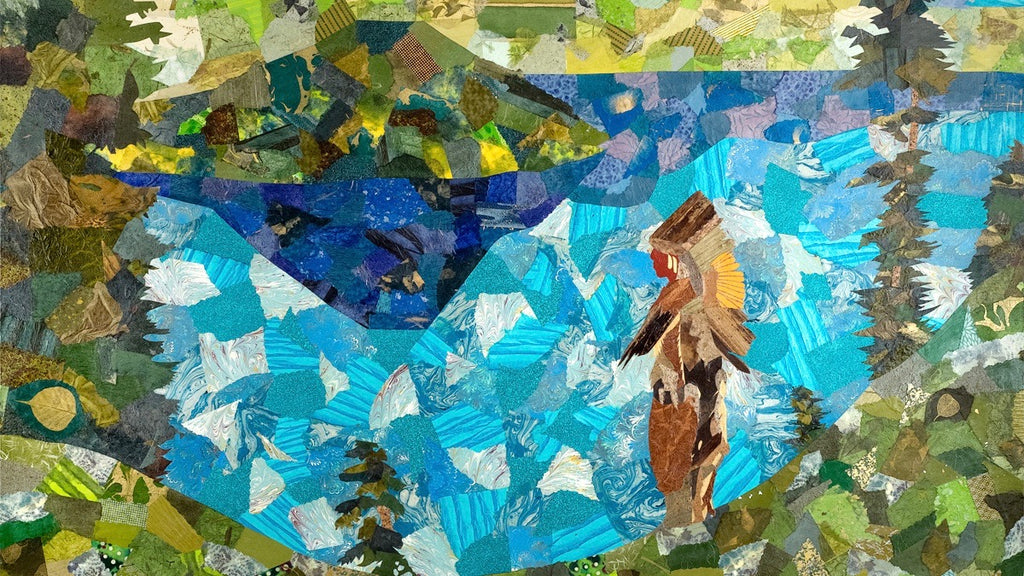Expressing Stories in Native Art

Seneca, Chinook Painter visits Sisters and Raven Makes Gallery
Mark Shelton’s paintings reflect moments of Native American identity—offering a prayer, weaving a blanket, reflecting upon sacred waters. He creates intense color fields and textures in his works by layering bits of exotic papers in the construction of his subjects. His distinct collages are further enhanced with boldly applied acrylics. The direction that his career and life now traverses is opposite the trajectory in which it commenced.
Mark grew up in the 70’s, another solidly Midwestern kid in the region that inspired the Heartland songs of John Mellencamp. Fully ignorant of his Native American heritage, he first came to know about “Indians” through Hollywood movies. What Mark didn’t know was that his grandmother belonged to the Seneca people of the Iroquois Confederacy. The reason he hadn’t been told was due to the verbal abuse his great grandparents and grandmother had endured throughout their lives. Some realizations, however, seem destined.
Early on Mark and his cousin John began identifying with American Indian ways, stereotyped as they were. As boys, they played Cowboys and Indians in mock battles, always embracing the indigenous side. It got to the point that John, though an adopted child of Italian origin, would claim and insist that he was Comanche, even to school officials. When he turned 14, Mark’s father finally told him of his Seneca heritage.
Mark moved to Oregon in 1984, where he began studying all Native American Peoples. Moving to New York City to attend art school, he graduated with honors from the Pratt Institute in 1991. Upon returning to Oregon, Mark began a career in earnest as a painter of Native American subjects.
Chief Cliff Snider (Leloo or Grey Wolf) of the Chinook people, partially raised in Sisters, Oregon, also came to learn of his heritage only after his early youth. It was ‘The Chief’ who took on the Native American mentorship of Mark and exemplified that it is proper to embrace that ancestry also. Chief Grey Wolf recommended, and the Chinook Tribe ceremonially bestowed, the title of Honorary Chinook Tribal Artist upon Mark in 2006.
Only those well versed in Native American history, indigenous treaties, rights and laws, along with current American Indian affairs might be aware of the complicated status regarding the Chinook People. Briefly—In 1851 a representative of the United States Government signed the Anson Dart Treaty with the Chinook People, a well-established tribe of the middle and lower regions of the Columbia River. Unbeknownst to them for a number of years, Congress did not ratify the treaty; therefore, they never were ‘a tribe’ according to the U.S. Government. Eventually, in early 2001, President Clinton finally gave Federal recognition and tribal status to the Chinook People. However, in an unprecedented and controversial move, President Bush revoked that recognition less than two years later.
The prestige of being the Honorary Chinook Tribal Artist affords both privileges and responsibilities. Mark states, “It has become my duty to educate, inform, and promote the Chinook and their significant ties to history, starting with their aid to the Lewis and Clark expedition and the opening of mercantile trade between Native and non-Native peoples in the Northwest via the Columbia River and Pacific Ocean. I feel a sense of responsibility to honorably represent the Chinook.”
The Native American art world holds a number of annual shows and markets that celebrate the artists. Two of them are juried and considered the preeminent venues, The Santa Fe Indian Market during August in New Mexico and The Heard Show during March in Phoenix, AZ. Mark has shown in both, receiving an award at The Heard.
One of the nation’s finer galleries, Wiford, on the elite Canyon Road of Santa Fe, New Mexico has represented Mark. Internationally, his works are carried in the Italian village of Vernazza, part of the ultra-picturesque Cinque Terre Coast. One art critic has described Mark’s strength’s as knowing “how to balance brilliant colors with brilliant colors in order to achieve a shimmering allure.”
Today, artwork is a key component for confirming, demonstrating, and celebrating the identity of many tribes, including those with Federal recognition and reservation lands. For tribes without that recognition, such as the Chinook, they are even more reliant upon this method of expression to help preserve their identity and culture. Mark Shelton, of the Seneca People and the Honorary Chinook Tribal Artist, embraces his duty and ardently endeavors.